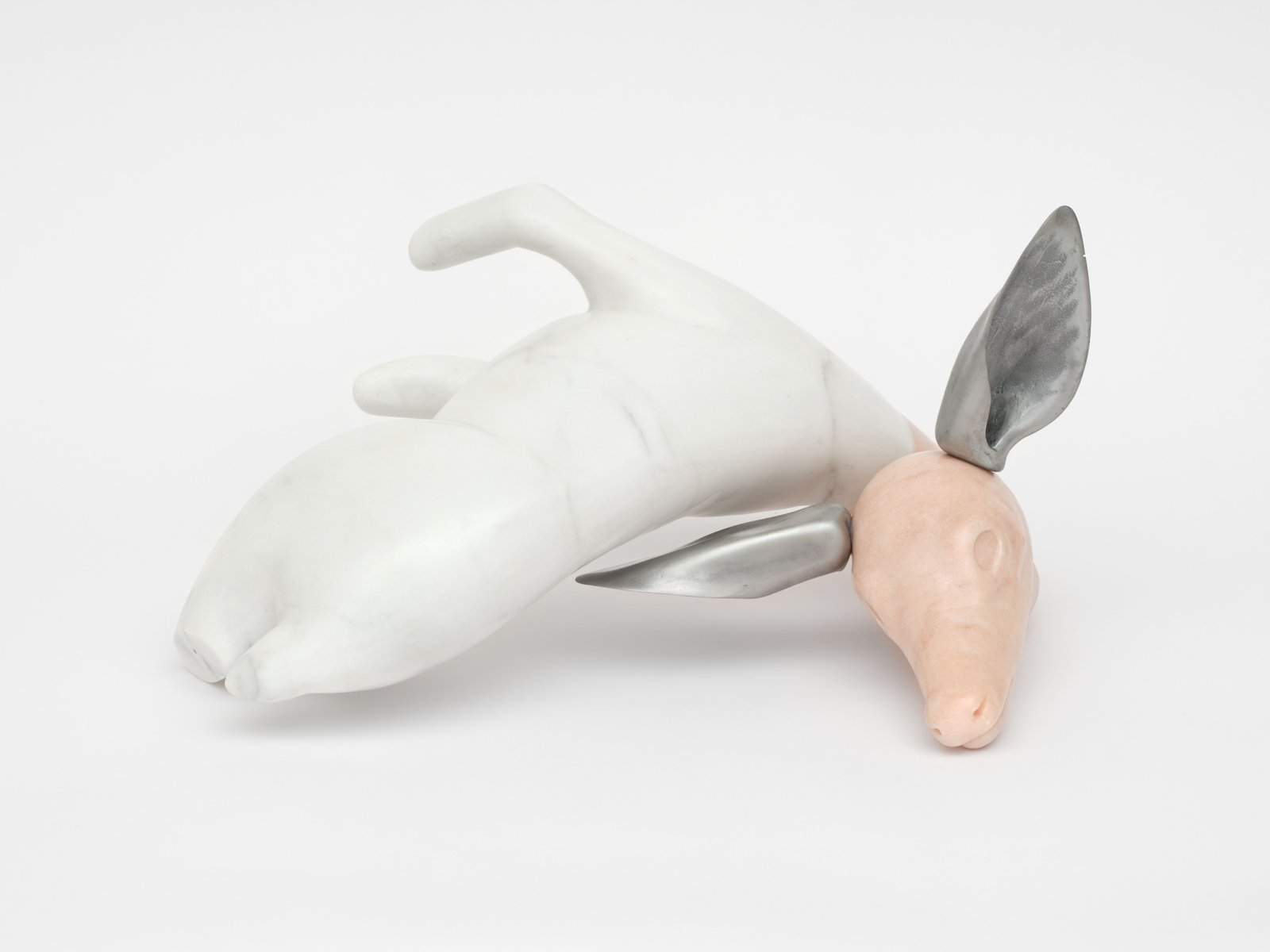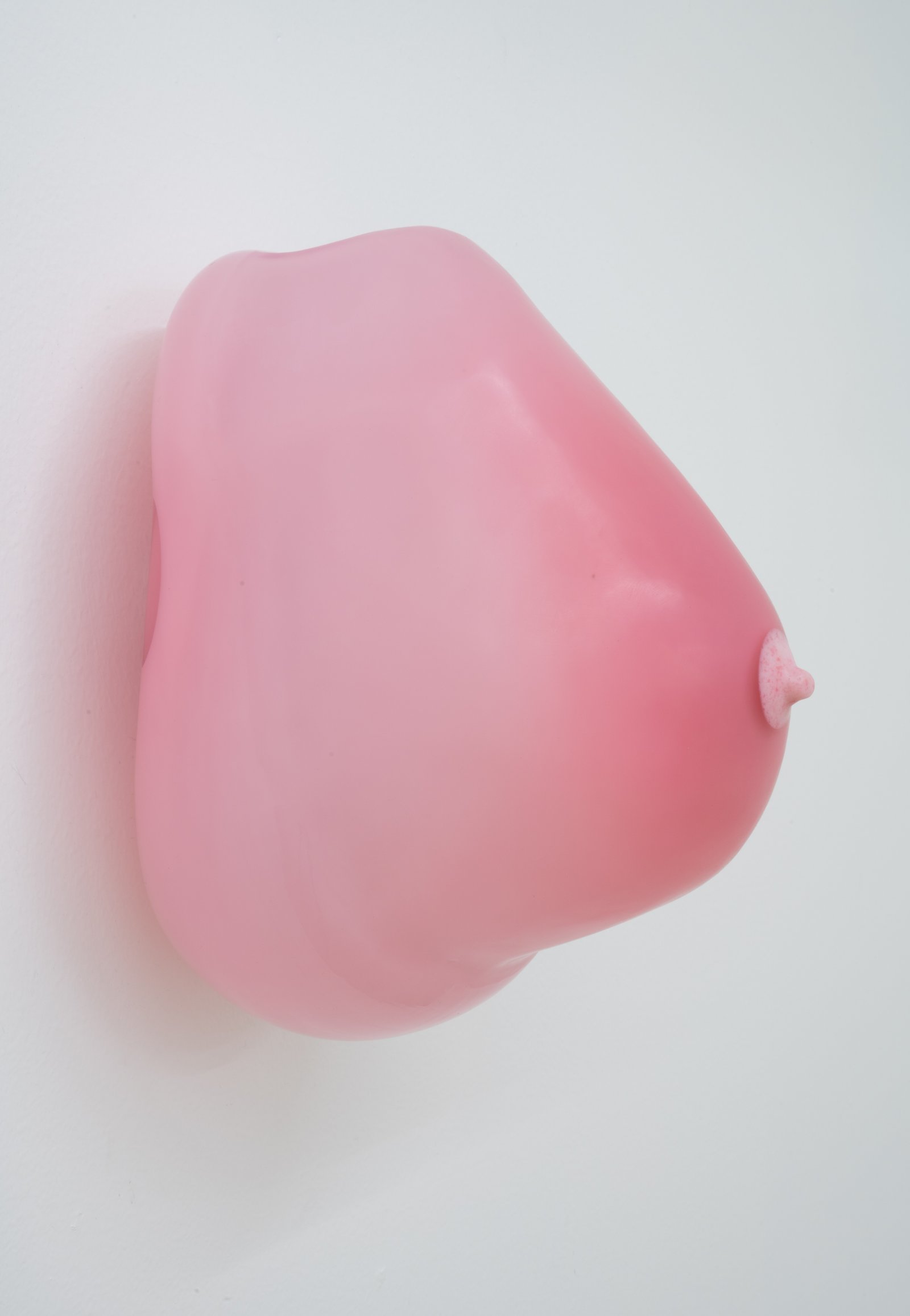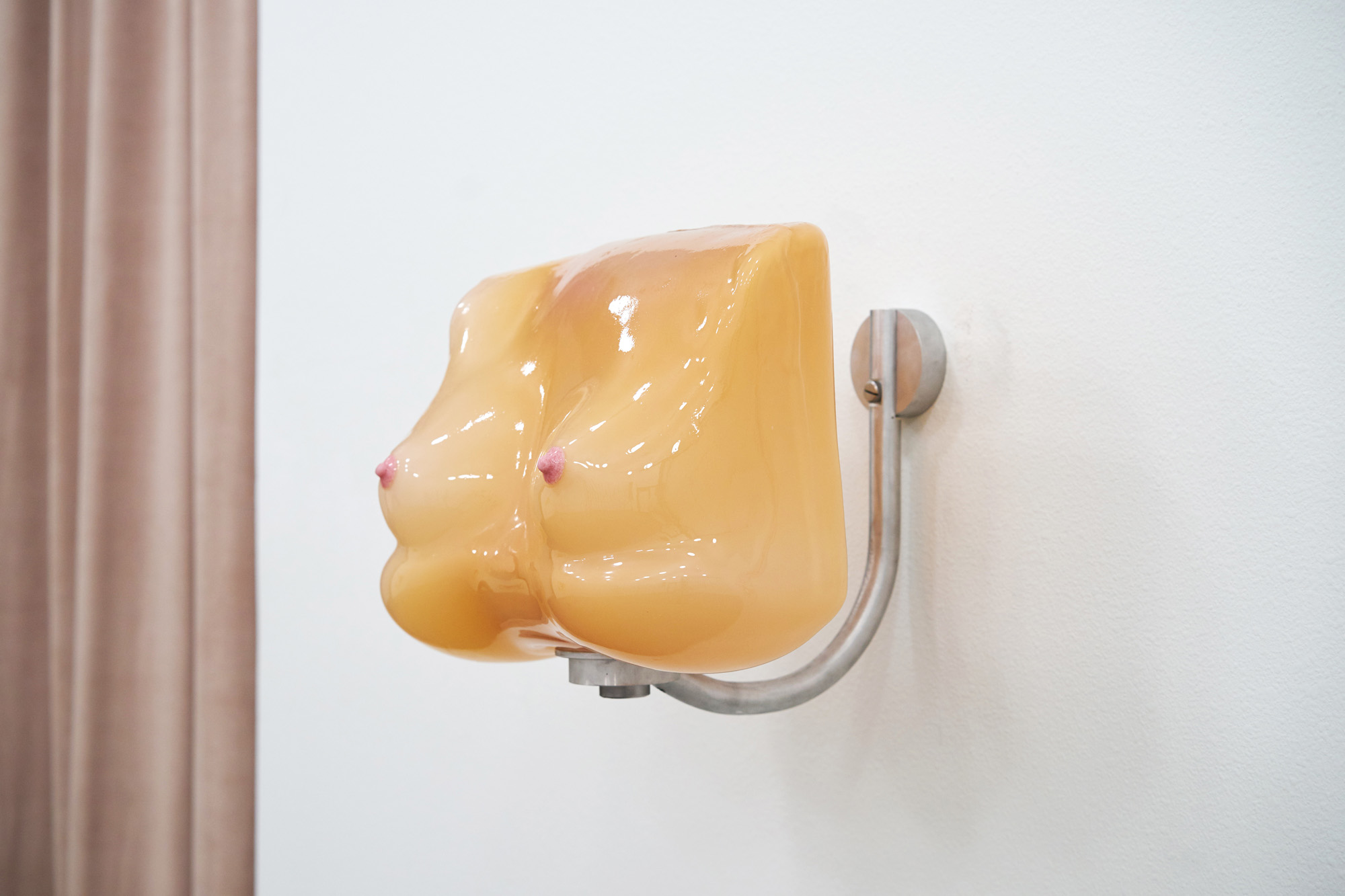Nevine Mahmoud: the implications of pleasure
The heart of the practice of Nevine Mahmoud is the expressive recreation of a symbolic process which takes shape in the encounter with her work
Nevine Mahmoud’s sculptures are symbols—concrete images—which hold together different elements, in turn expressing the process that led to their creation. They do not refer to other meanings, but in their sculptural physicality, reveal the complexity of desires and impulses. Less subject to the arbitrariness of signs, they are figures that come from afar. They address bodily sensations before rational thought, while affecting what we have in common with animals.
Beyond the seduction of surface and materials, beyond possible interpretations, there is an archetypal system that emerges from the flow of its individual iterations. Whether it is a marble peach revealing its interior, an alabaster mouth, a portal, an erogenous zone or a skinless deer, the heart of Mahmoud’s practice is the expressive recreation of a symbolic process which takes shape in the encounter with her work.
A rigorous and instinctive attraction guides the choice of subjects, which are translated into symbols on the basis of their intrinsic qualities such as spatiality, function, material, density, and structure. When attracted to an object, the artist asks herself what is happening to her body, and observes the flow of images that gravitate in her mind, images which cannot be translated into conceptual reduction. These self-evident processes aim to restore the complexity of feelings that bring together restlessness and eroticism, fragility and violence, attraction and estrangement.
The works Twisted Faun and Josefine (both 2023) depict two life-size fawns, whose bodies of white Carrara marble, aluminium and Portuguese pink marble are twisting and thus evoking contrasting feelings. In these sculptures, the ears have been sculpted by robotic arms based on renderings from 3D scans, while the bodies and heads are handmade.

Displaying a strange sensuality that reveals itself precociously, the fawn is charming in its naked vulnerability, almost assuming a surrendering attitude. In the two sculptures, the animal’s flesh becomes cold and hard, gently challenging the limits of the material. The absence of the skin reveals complicated layers which blurs the opposition between inside and outside. In this way, the surface tightens due to the density of the solid, deep stone, which creates a kind of tactile contradiction.
The precious nature of the marble, as well as the implicit historical significance, are diluted in the sinuous and alienating fragility of the two creatures, which recall childhood in their delicate aesthetics, gentle and vernacular at times.
In order not to distract attention from the hybrid and perturbing nature of the young deers, and to convey the contradictory complexity of feelings, the hooves are absent. What matters most is indeed the composition of the single parts, like a robotic, animal cyborg. Like in the symbol, the function of holding things together is crucial—the ghostly, incomplete creatures thus generate dark undertones.

The pair of deers do not allow access to one’s inner self. As in classical statues, faces do not express emotion, unlike their ambiguous bodies which contort. But while the eyes are impenetrable, the ears instead represent the abyss of interiority. Mahmoud’s works are built around her interest in allowing physical matter to pass through: lips, doors, chasms. The deer has poor eyesight, especially in daylight, while the ears are vital, mobile, and developed organs. The only slightly disproportionate parts—the ears—are the most intimate and inscrutable elements.
The perturbing dimension runs subterraneously and constantly, through Mahmoud’s practice. The joy of eroticism is often accompanied by repulsive attractions or alienating effects: in flowers, fruit, inflatable objects, and bodies that resemble works by Louise Bourgeois, as Blind Man’s Buff (1984) and Alina Szapocznikow, for example her “Sculpture-Lampe” series. The fragmented or dismembered body is disturbing, beyond the often dominant beauty and eroticism; as occurs with the blown glass breasts (breast (jamón jamón), 2019), the polyester and plastic lips (Double Lip, 2016), the pink marble tongues (Tongue Drain, 2018), the glass and resin busts (Bust Phantom Li, 2019) close to the aesthetic sensitivity of Robert Gober and Beverly Edmier. But it is with these works that the artist enhances the perception of the disquieting and contradictory aspects of her practice, intentionally reducing humour and eroticism. Through a laboured process, the animal’s forms take on a sinister and subtly violent presence which complicates the pleasure of viewing.

With these two sculptures Mahmoud introduces an important technological component to the sculptural process, one which lays the foundations for a potential redefinition of it: her works are derived from robotic arms as well as her gestures. The complicated mixture of the robotic and the manual makes for a highly technical process of layering; in fact, the operation of the machinery introduces an element of unpredictability, a disorder that must be welcomed in the composition.
Among Mahmoud’s main influences, Charles Ray’s palm-sized sculpture Handheld Bird (2006), which represents a late-stage bird embryo, is like Josefine and the Twisted Faun; the work shows an alien and frightening corporeal event, but is at the same time gentle and fragile.
The unconscious layering of sweetness, familiarity, pain, and eroticism harks back to the perturbing childhood nostalgia of Disney’s Bambi (1942), which profoundly influenced Mahmoud’s perception of the deer. (1) The animated film is based on the novel Bambi: Eine Lebensgeschichte aus dem Walde (1923) by Austro-Hungarian author and critic Felix Salten. It is perhaps lesser known that Salten is also the author of the banned and initially unattributed erotic novel Josefine Mutzenbacher; oder Die Geschichte einer Wienerischen Dirne von ihr selbst erzählt (1906), which retraces the life of a prostitute from maturity to childhood, and from which the title of the pink marble sculpture is taken.
In the “Breast” series (2018-2020), opalescent blown glass sculptures represent individual female breasts, a painful component had already emerged in contrast with the solid materials and finished forms. (2) But it is with the two fawn sculptures that the shift from the overlap between pleasure and desire to that between pleasure and pain takes place.

The artist refers to the sensual ecstasy of the saints and to the piercing wounds of love, as in the cases of the saints Veronica Giuliani, Juan de la Cruz, and of course Teresa of Avila, who appears in Gian Lorenzo Bernini’s depiction on the cover of the artist’s copy of George Bataille’s book L’érotisme (1957). In the exhibition, it is as if the fawns are consumed by the agony of ecstasy, contorting their bodies into alien, sinuous poses, in which the boundary between female archetype and androgyny is blurred. While the first deer was entitled Fawn (she) (2022), the subsequent manifestation of the figure refers to the faun, a male mythological deity.
Perhaps the most intense of all physical sensations, pain tends to raise the question of its origin; the increase of suffering in the sculptures therefore requires an effort of interpretation. Pain is not an event limited to a specific area of the body, but reveals itself to consciousness, it lives between mind and body. In its most extreme conditions—as in, ecstasy—a loss of awareness occurs. Mutilations are only perceived a posteriori, not at the moment they occur. Both pain and pleasure live in the expectation and emptiness of time; to overlap them is to deploy an unprecedented temporal sculptural element. In reason-driven modernity, the representation of lacerating pain is often removed, re-emerging from the 1700s onwards particularly in fantastic literature, for instance the writings of the Marquis de Sade and Edgar Allan Poe. (3) Regarding this perspective, it is interesting that these two sculptures are described as ghostly figures.

There is a relationship between removing the skin and undressing. In the experience of being exposed, the power over the beholder and the consequences of the possible objectification of one’s image coexist. According to Mahmoud, these are perhaps predominant, even when the power is experienced by the feminine. In her Ball stripped bare (2018) the surface of a carved pink marble beach ball is removed and used to cover the floor.

Thus the stone ball is exposed, projecting its synthetic, coloured skin into space. The title of the work humorously recalls Marcel Duchamp’s Bride Stripped Bare by her Bachelors, Even (1915-1923), whose erotic objects have always attracted Mahmoud. These power relations are crucial, influencing the ways in which visual forms are appealing to both the male and female gaze. A viewer’s inability to touch Nevine Mahmoud’s sculptures, as prohibited by the exhibition spaces, compounds the existing prohibition on touching body-objects. Things get complicated by observing that, in addition to the overlap between pleasure and pain, we must consider pleasure derived from submission, as in a sort of intensification of the desire caused by frustration due to delayed gratification; taken to an extreme, this deferral manifests as extreme coldness. (4) In spite of the ambiguity of their postures, the sculpted fawns are at once sinuous and inert, detached and suffering: the opposition between hot and cold is lost. They allude to the attempt of the conscience to reduce itself to nothing, making itself objects suffocated by the other’s abysmal subjectivity. (5) Faced with this further obscure complication —which calls into question political and social reflections— irony, lightness and the delicate fragility of the bodies become providential safewords.
1 Mary Walling Blackburn, “The deer, when it is tired,” e-flux Journal #137, June 2023.
2 Eva Fabbris, “In the middle of nowhere,” CURA.33, March 2020.
3 Karl Heinz Bohrer, Die Ästhetik des Schreckens: Die pessimistische Romantik und Ernst Jüngers Frühwerk, (Munich: Hanser, 1978), p.173-74.
4 Gilles Deleuze, Présentation de Sacher-Masoch. Le froid et le cruel, (Paris: Minuit, 1967), p. 276.
5 Jean-Paul Sartre, Saint Genet comédien et martyr (oeuvres complètes de Jean Genet, I), (Paris: Éditions Gallimard, 1952).
September 19, 2023
